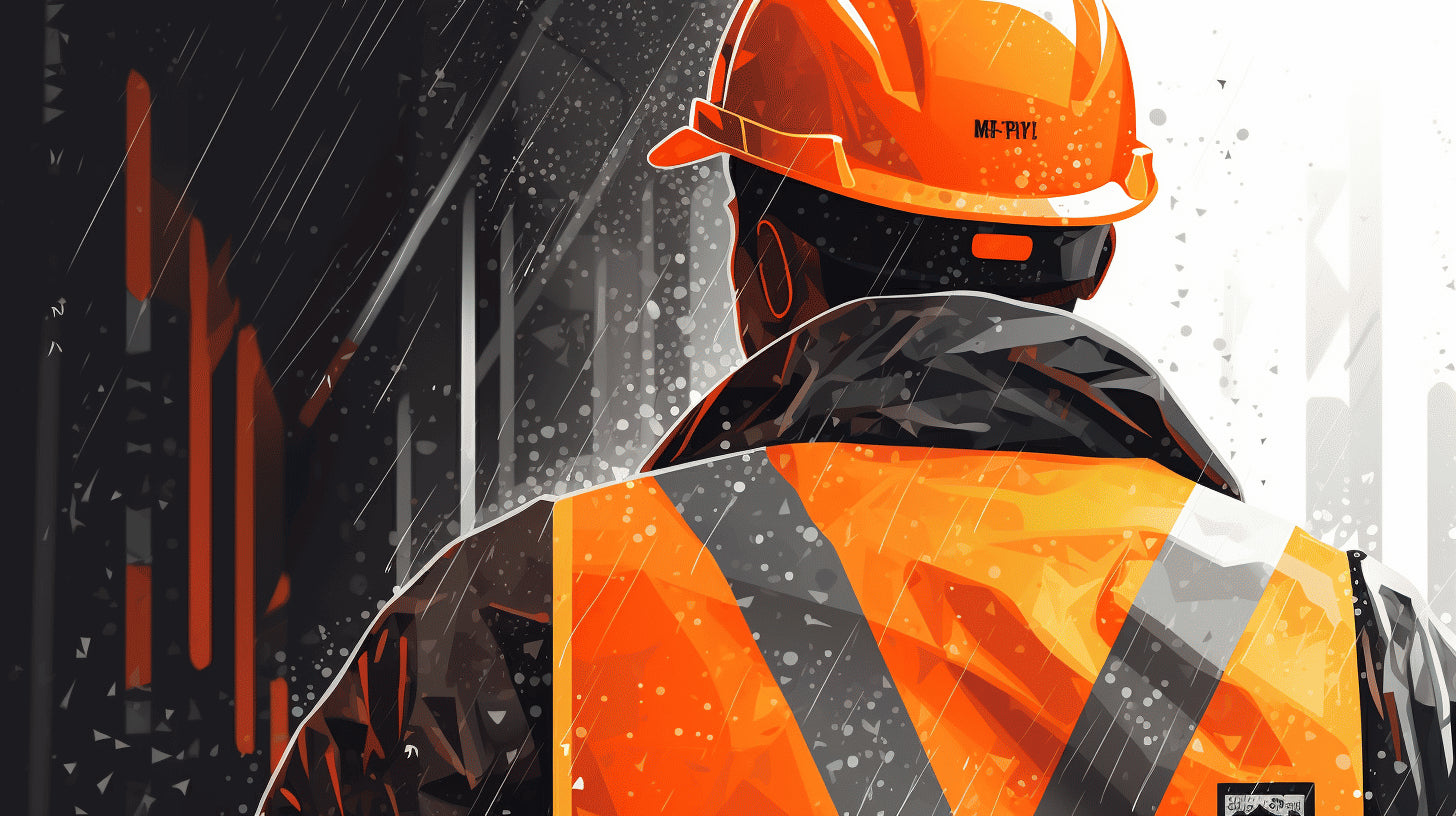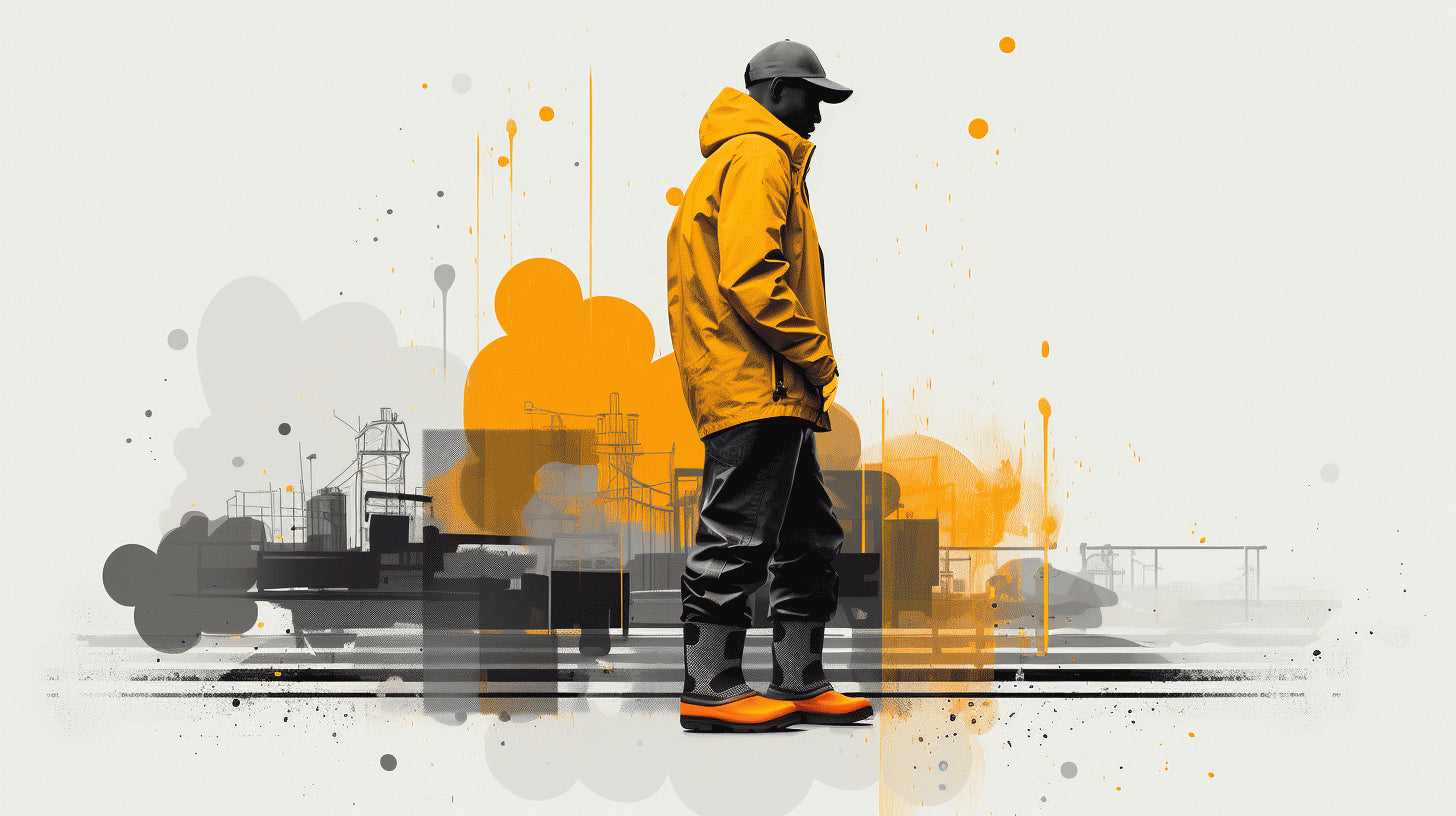Weathering the storm is no easy task, especially in the high-demand field of construction. Rain or shine, the job must go on. But how can one ensure safety and efficiency when the skies decide to open up? Enter tear-resistant rain gear—an unsung hero of the construction industry!
As construction involves labor-intensive tasks often carried out in the open and exposed to the elements, ensuring worker safety becomes a top priority. One of the essential elements that contribute to a worker’s safety comes in the form of appropriate clothing. Gone are the days where a simple poncho would suffice. Today's safety standards require sturdy, reliable, and tear-resistant rain gear that withstands the rigors of a challenging work environment while offering much-needed weather protection.
In the upcoming sections, we'll dive into the world of tear-resistant rain gear, discussing its manufacturing process, the materials used, and its critical role in ensuring safety at the construction site. Furthermore, we'll guide you on choosing durable, comfortable, and suitable rain gear for construction work, and provide simple-to-follow tips on its maintenance and care. By the end of this article, you'll see why tear-resistant rain gear is nothing less than essential equipment for construction safety.
Understanding Tear-Resistant Rain Gear
There's nothing worse than getting caught in a downpour, only to find your raincoat hasn’t held up to the task. If this sounds familiar, it's high time you considered investing in tear-resistant rain gear. Durable, sturdy and dependable, these items are made specifically to shrug off the rigors of the weather with ease, and today, we aim to delve a little deeper into just what makes them so effective.
Definition
Tear-resistant rain gear refers to outerwear– jackets, pants, or complete suits - designed specifically for protection against rain. What separates it from traditional rain gear is its enhanced durability. Crafted to resist tearing even when subjected to harsh conditions, it ensures you remain dry and comfortable in the face of heavy rain or snow. But what makes tear-resistant rain gear so resilient? Let's discover in the next section.
Manufacturing Process
The secret to tear-resistant rain gear's strength lies in its manufacturing process. Unlike ordinary rain gear, the process starts by weaving high-strength threads into an extremely dense fabric.
This fabric is then treated with a water-resistant coating. Depending on the product, this could be a Teflon coating or a rubberized layer, both of which are known for their superior water repelling qualities. These factors combine to create a robust armor that defends against not only rain but also the ravages of time.
It's wonderful how this all comes together, but none of it would be possible without the right materials.
Materials Used
The star of the show in tear-resistant rain gear is undeniably the fabric. Most manufacturers lean towards high-strength nylon or polyester due to their delightful trifecta of qualities - durability, lightweight, and water resistance. Apart from this, a Teflon or rubber coating is often applied to bolster the fabric’s waterproofing ability.
Some manufacturers incorporate Kevlar, a synthetic fiber known for its exceptional strength and resistance to heat and cuts. It's the same material used in making bulletproof vests - a testament to its unparalleled toughness!
In conclusion, tear-resistant rain gear is a marvel of modern manufacturing, a perfectly balanced blend of durable materials and innovative techniques. Whether you're a hiker bracing for a stormy ascent or a cyclist navigating your way through a rainy city, it's the reliable companion that ensures you stay dry, no matter what.
Importance of Tear-Resistant Rain Gear in Construction Safety
Construction sites are well-known for their challenging environments and elevated risk factors. A crucial aspect often overlooked is the substantial role of weather conditions, particularly rain, in shaping these risks. An optimal solution gaining attention in the construction industry lately is the implementation of tear-resistant rain gear. This practical application serves a multifaceted role from protection from harsh weather to injury prevention, ultimately leading to cost-effectiveness.
Protection from Harsh Weather
Firstly, the importance of shielding workers from unforgiving weather can never be overstated. With the unpredictable and harsh conditions that construction sites often face, the need for a robust solution becomes imperative.
- Tear-resistant rain gear is tailor-made to resist harsh weather, and it adapts to sudden changes in climatic conditions. Its innovative design prevents water invasion, therefore keeping workers dry and comfortable.
- It also provides a much-needed layer of insulation - a feature highly beneficial in colder regions. Insulation, combined with the waterproofing effect, can significantly reduce the risk of exposure to elements, thus preventing conditions like hypothermia.
- Protective clothing can keep dirt and debris at bay. This prevents discomfort to workers and allows them to focus better on their tasks.
Increased Work Efficiency
Another less apparent advantage of tear-resistant rain gear pertains to the realm of productivity.
- Workers wearing comfortable and protective clothing like tear-resistant rain gear can carry out their tasks without worrying about the repercussions of unfavorable weather, which directly spikes work efficiency.
- It also rules out the need for frequent changing of clothes hampered by wet weather, thus saving precious work hours.
Prevention of Work-related Injuries
Undeniably, the most significant contribution of tear-resistant rain gear lies in the dramatic reduction of work-related injuries.
- Wet and slippery conditions are a common cause of accidents on construction sites. Providing workers with rain gear that keeps them dry can significantly reduce the risks of slips, trips, and falls.
- The gear's tear-resistant property ensures that it remains intact even under challenging circumstances, reducing the risk of sharp objects penetrating through the clothing and causing injuries.
Cost-effectiveness in the Long Run
While upfront costs for high-quality rain gear may seem high, it is cost-effective in the long run.
- Consistent use of tear-resistant rain gear minimizes injury-riddled downtime, which in turn eliminates subsequent costs such as compensation, medical treatments, and loss in productivity.
- Due to the gear's durability, replacement costs are also low. The reduced frequency of replacing personal protective equipment saves significant costs in the long run.
In the dynamic world of construction safety, viewing tear-resistant rain gear as merely clothing to keep workers dry would be oversimplifying its multifaceted benefits. From creating a safer working environment to boosting efficiency, it is an indispensable tool that aids in constructing a sturdy foundation for cost-effective and safety-conscious environments. Let's together champion the cause for a safer and more efficient construction sector.
Key Features of High-Quality Tear-Resistant Rain Gear
When it comes to surviving the rain without surrendering to sogginess, high-quality, tear-resistant rain gear is the only way to go. The rain jacket that comes to your rescue will have a number of key features. They need to be durable, waterproof, breathable, comfortable, and offer visibility features. Here's what you need to consider when shopping for the best tear-resistant rain gear:
Durability
Durability is the key to effective rain gear. High-quality jackets will be manufactured using abrasion-resistant materials like nylon and polyester, which aid in preventing tearing and snagging. A good rain gear will have seams which are sealed to prevent the ingress of water. Furthermore, these jackets should also trump tests of time, ideally providing several years of reliable service.
Waterproofing
Waterproofing is an obvious, but essential feature. You must look for rain gear with an excellent water column rating, but the real proof of a jacket's waterproofing ability lies in its ability to keep you dry in a downpour, which usually comes from tried-and-tested feedback. Look for rain gear that features a waterproof membrane or coating for added peace of mind.
Breathability
Being made watertight doesn't mean your rain gear should leave you sweaty. Breathing features contribute to your comfort by enabling sweat vapor to escape, which helps prevent moisture from building up inside. A jacket with great breathability ensures your comfort level is maintained regardless of how nasty the weather turns.
Comfort and Fit
Apart from all technical parameters, the key factor in selecting any apparel is the 'comfort and fit'. Look for features that improve comfort like adjustable cuffs, a tailored fit, or perhaps a drawstring hem, to keep the jacket in place regardless of your movements. Also, a good rain jacket must have enough space for you to wear a jumper or a thermal layer beneath during colder weather.
Visibility Features
Last but not least, when it comes to choosing the perfect rain gear, don't overlook the importance of visibility. Especially if you're a keen runner or cyclist who often finds themselves in poor lighting conditions, the rain gear you go for should have reflective patches, bands, or piping. This way, you're not only protected from the rain but also visible to others.
In summary, the key features of a high-quality tear-resistant rain gear include durability, waterproofing, breathability, comfort and fit, and visibility features. These elements contribute to both efficiency and longevity, ensuring you remain dry and comfortable regardless of the conditions out there. Therefore, delve deep into these features while selecting your rain gear, and you'll never regret a rainy day again!
Maintenance and Care for Tear-Resistant Rain Gear
Tear-resistant rain gear has become a household favorite due to its combination of comfort, style, and practical protection. As beneficial as these items are, maintaining their superior quality isn't a coincidence. It requires conscientious care and treatment. This article unveils the mystery behind the upkeep of your tear-resistant rain gear, from regular cleaning to proper storage and more.
Regular Cleaning
Regular cleaning of your tear-resistant rain gear is quintessential to prolong its life and maintain the gear's water-repellent properties.
- Handwash: They respond well to hand washing with mild detergent. Just ensure that the water isn't exceedingly hot; lukewarm will serve just fine.
- Machine wash: If it's permissible as per your gear's care label, opt for a gentle cycle in your washing machine. As always, a gentle detergent is recommended.
- Drying: Post-wash, let the gear drip dry under shade to prevent UV damage.
- Waterproofing: Every few washes, consider using a waterproofing solution to refresh the water-repellent properties of the gear. Simply submerge your gear in the solution, ensuring it's soaked thoroughly.
Proper Storage
Proper storage is the next key to maintaining the condition of your rain gear.
- Dry-as-Bone: Make certain gear is completely dry before storing it.
- Airflow: Store it in a location that allows air to circulate freely around it.
- Avoid Heat: Keep it away from heat sources like radiators or air vents to prevent damage to the waterproof coating.
Damage Inspection
Regular damage inspections can help spot minor issues before they propagate and require costly repairs or replacements.
- Visual Check: Perform a routine check of your gear for any noticeable tears or rips.
- Water Test: Occasionally place the gear under running water and check for any areas where the water seeps through.
- Fix It, Don’t Ditch It: Small tears or holes can be fixed with specialty repair kits instead of replacing the whole gear.
With these maintenance and care guidelines, your tear-resistant rain gear will not only last longer but continue to keep you dry and comfortable throughout the rainy season. Remember, proper care for your rain gear not only saves you money in the long run but is also eco-friendly as it minimizes waste.
How to Choose the Right Tear-Resistant Rain Gear for Construction Work
Choosing the ideal rain gear that resists tear for construction work can sometimes feel like a herculean task. However, it doesn't have to be that way. With the right knowledge and mindfulness about specific crucial factors, it can become a more effortless and successful endeavor.
Assessing the Weather Conditions and Work Demands
Before embarking on a quest to select your perfect work gear, understanding the weather situation and work demands will lay a solid foundation for the choice-making process.
- Reviewing the weather conditions: If you are working in regions with frequent heavy rainfalls, you would require rain gear that is not just tear-resistant, but also highly waterproof. Lighter gear would be more appropriate for regions with moderate to light rainfall patterns.
- Evaluating work demands: The intensity and type of construction work would also significantly influence your decision. For instance, if it involves a lot of heavy lifting and movement, you might want to consider tear-resistant rain gear that offers flexibility and ease.
Checking the Gear's Specifications
Next, dive into the specifics of the gear.
- Material: The best tear-resistant rain gears are usually made of heavy-duty materials like PVC (Polyvinyl Chloride) or well-coated fabrics, guaranteeing durability and tear-resistance in the toughest of conditions.
- Design features: Look for features that enhance the gear's functionality, like reinforced areas that are more prone to wear and tear, adjustable components for a better fit, reflective strips for visibility, and venting features to avoid overheating.
Trying on the Gear
Finally, take out some time to try on the gear. Make sure it's comfortable, allows ease of movement and fits well. After all, a gear that affects your comfort or restricts your mobility would only increase your challenges at work, rather than alleviating them.
Remember that the true test of a gear's suitability is performance in action. Give it some "field test" in a controlled setting if possible, to evaluate its tear-resistance and comfort under realistic conditions.
By thoughtfully assessing weather conditions, checking the gear's specifications, and trying it on, you'll be on your way to choosing rain gear that is not just tear-resistant, but also perfect for your construction requirements. So, endure no more soggy workdays; arm yourself with the right gear and let your productivity soar, come rain or sunshine!
Conclusion
Embracing the necessity of tear-resistant rain gear contributes significantly to construction safety protocols. As an essential part of the worker's wardrobe, these specialized clothes offer protection from harsh weather, increased efficiency, prevention of work-related injuries, and long-term cost savings. When you invest in high-quality rain gear, such as those offered by Hurricane Raingear, you're not only investing in your team's safety but also in their comfort and efficiency at work.
Remember, the durability and longevity of your rain gear will also largely depend on the care and maintenance it receives. So, be mindful of regular cleaning, proper storage, and routine damage checks. When you need to choose new gear, examining weather conditions, work demands, gear specifications, and fit ensures you make the best choice for your construction site needs.
In essence, tear-resistant rain gear is a proactive step towards ensuring that construction sites become safer spaces. With the right gear, you are assured of a competent, happy, and safety-conscious workforce. Ready to make the switch? Save on potential accident costs and worker discomfort by exploring Hurricane Raingear's selection of 100% waterproof and rip-resistant rain gear today!
Frequently Asked Questions
-
What is tear-resistant rain gear?
Tear-resistant rain gear is a type of protective clothing designed to withstand tearing or ripping when exposed to challenging conditions, such as heavy rain, strong winds, or rough construction environments.
-
Why is tear resistance important in rain gear for construction workers?
Tear resistance is crucial in rain gear for construction workers as they are often exposed to harsh conditions and potential hazards, such as sharp objects or abrasive surfaces. Tear-resistant gear ensures durability and protection for the wearer.
-
What are the key features to look for in tear-resistant rain gear?
When choosing tear-resistant rain gear, look for features like reinforced seams, heavy-duty materials (such as ripstop fabric), double stitching, quality zippers, adjustable cuffs, and a good fit to provide maximum protection and flexibility.
-
Can tear-resistant rain gear be worn in warm climates?
Yes, tear-resistant rain gear is available in various designs and materials suitable for different climates. Look for gear with breathable fabrics, vents, or moisture-wicking properties to prevent overheating when working in warm climates.
-
How should tear-resistant rain gear be maintained?
To maintain the tear resistance and longevity of rain gear, it is recommended to follow the manufacturer's care instructions. Generally, it involves regular cleaning, avoiding harsh chemicals, proper storage, and occasional reproofing to ensure water repellency.























Leave a comment
This site is protected by hCaptcha and the hCaptcha Privacy Policy and Terms of Service apply.